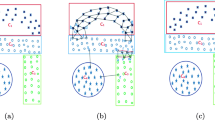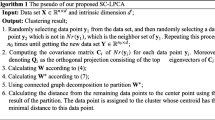Abstract
The designation of the cluster number K and the initial centroids is essential for K-modes clustering algorithm. However, most of the improved methods based on K-modes specify the K value manually and generate the initial centroids randomly, which makes the clustering algorithm significantly dependent on human-based decisions and unstable on the iteration time. To overcome this limitation, we propose a cohesive K-modes (CK-modes) algorithm to generate the cluster number K and the initial centroids automatically. Explicitly, we construct a labeled property graph based on index-free adjacency to capture both global and local cohesion of the node in the sample of the input datasets. The cohesive node calculated based on the property similarity is exploited to split the graph to a K-node tree that determines the K value, and then the initial centroids are selected from the split subtrees. Since the property graph construction and the cohesion calculation are only performed once, they account for a small amount of execution time of the clustering operation with multiple iterations, but significantly accelerate the clustering convergence. Experimental validation in both real-world and synthetic datasets shows that the CK-modes algorithm outperforms the state-of-the-art algorithms.
Similar content being viewed by others
References
Shiokawa H, Fujiwara Y, Onizuka M. SCAN++: Efficient algorithm for finding clusters, hubs and outliers on largescale graphs. Proceedings of the VLDB Endowment, 2015, 8(11): 1178-1189.
Zhang W P, Li Z J, Li R H, Liu Y H, Mao R, Qiao S J. MapReduce-based graph structural clustering algorithm. Journal of Software, 2018, 29(3): 627-641. (in Chinese)
Wu Y, Zhong Z N, Xiong W, Chen L, Jing N. An efficient method for attributed graph clustering. Chinese Journal of Computer, 2013, 36(8): 1704-1713. (in Chinese)
Guo T, Ding X W, Li Y F. Parallel K-modes algorithm based on MapReduce. In Proc. the 3rd International Conference on Digital Information, Networking, and Wireless Communications, February 2015, pp.176-179.
Zhou F F, Li J C, Huang W, Wang J H, Zhao Y. Extending dimensions in Radviz for visual clustering analysis. Journal of Software, 2016, 27(5): 1127-1139. (in Chinese)
Noori-Daryan M, Taleizadeh A A, Govindan K. Joint replenishment and pricing decisions with different freight modes considerations for a supply chain under a composite incentive contract. Journal of the Operational Research Society, 2018, 69(6): 876-894.
Huang Z X. Clustering large data sets with mixed numeric and categorical values. In Proc. the 1st Pacific-Asia Conference on Knowledge Discovery and Data Mining, February 1997, pp.21-35.
Ahmad A, Dey L. A method to compute distance between two categorical values of same attribute in unsupervised learning for categorical data set. Pattern Recognition Letters, 2007, 28(1): 110-118.
Park H S, Jun C H. A simple and fast algorithm for K-medoids clustering. Expert Systems with Applications, 2009, 36(2): 3336-3341.
Zadegan S M R, Mirzaie M, Sadoughi F. Randed K-medoids: A fast and accurate rank-based partitioning algorithm for clustering large datasets. Knowledge-Based Systems, 2013, 39: 133-143.
Ferrarini L, Olofsen H, Palm W M, van Buchem M A, Reiber J H C, Admiraal-Behloul F. GAMEs: Growing and adaptive meshes for fully automatic shape modeling and analysis. Medical Image Analysis. 2007, 11(3): 302-314.
Ng M K, Chan E Y, So M M C, Ching W K. A semisupervised regression model for mixed numerical and categorical variables. Pattern Recognition, 2007, 40(6): 1745-1752.
Bachem O, Lucic M, Hassani S H, Krause A. Approximate K-means++ in sublinear time. In Proc. the 30th AAAI Conference on Artificial Intelligence, February 2016, pp.1459-1467.
Arthur D, Vassilvitskii S. K-means++: The advantages of careful seeding. In Proc. the 18th Annual ACM-SIAM Symposium on Discrete Algorithms, January 2007, pp.1027-1035.
Liu Y C, Li Z M, Xiong H, Gao X D,Wu J J. Understanding of internal clustering validation measures. In Proc. the 10th IEEE International Conference on Data Mining, December 2010, pp.911-916.
Liu Y C, Li Z M, Xiong H, Gao X D,Wu J J. Understanding and enhancement of internal clustering validation measures. IEEE Transactions on Cybernetics, 2013, 43(3): 982-994.
Robinson I, Webber J, Eifrem E. Graph Databases (1st edition). O’Reilly Media, 2013.
Akpan N P, Iwok I A. A minimum spanning tree approach of solving a transportation problem. International Journal of Mathematics and Statistics Invention, 2017, 5(3): 9-18.
Li M C, Han S, Shi J. An enhanced ISODATA algorithm for recognizing multiple electric appliances from the aggregated power consumption dataset. Energy and Buildings, 2017, (140): 305-316.
Hesthaven J S. A stable penalty method for the compressible Navier-Stokes equations: II. One-dimensional domain decomposition schemes. SIAM Journal on Scientific Computing, 1997, 18(3): 658-685.
Jin X, Han J. K-medoids clustering. In Encyclopedia of Machine Learning, Sammut G, Webb G I (eds.), Springer, 2016, pp.564-565.
Han L S, Xiang L S, Liu X Y, Luan J. The K-medoids algorithm with initial centers optimized based on a P System. Journal of Information and Computational Science, 2014, 11(6): 1765-1773.
Kang Z, Peng C, Cheng Q. Clustering with adaptive manifold structure learning. In Proc. the 33rd Int. Conference on Data Engineering, Apr. 2017, pp.79-82.
Nehak D, Dehak R, Glass J, Reynolds D, Kenny P. Cosine similarity scoring without score normalization techniques. In Proc. the Speaker and Language Recognition Workshop, June 2010, Article No. 15.
Cheng H, Zhou Y, Yu J X. Clustering large attributed graphs: A balance between structural and attribute similarities. ACM Transactions on Knowledge Discovery from Data, 2011, 5(2): Article No. 12.
Chang L J, Li W, Lu Q, Zhang W J, Yang S Y. pSCAN: Fast and exact structural graph clustering. IEEE Transactions on Knowledge and Data Engineering, 2017, 29(2): 387-401.
Schubert E, Sander J, Ester M, Kriegel H P, Xu X W. DBSCAN revisited, revisited: Why and how you should (still) use DBSCAN. ACM Transactions on Database Systems, 2017, 42(3): Article No. 19.
Du Z H, Li Y B. An improved BIRCH clustering algorithm and application in thermal power. In Proc. the 2010 International Conference on Web Information Systems and Mining, October 2010, pp.53-56.
Xiong H, Wu J J, Chen J. K-means clustering versus validation measures: A data-distribution perspective. IEEE Transactions on Systems, Man, and Cybernetics, Part B, 2009, 39(2): 318-331.
Wu J J, Xiong H, Chen J. Adapting the right measures for K-means clustering. In Proc. the 15th ACM SIGKDD International Conference on Knowledge Discovery and Data Mining, June 2009, pp.877-886.
Author information
Authors and Affiliations
Corresponding author
Electronic supplementary material
ESM 1
(PDF 549 kb)
Rights and permissions
About this article
Cite this article
Wang, DW., Cui, WQ. & Qin, B. CK-Modes Clustering Algorithm Based on Node Cohesion in Labeled Property Graph. J. Comput. Sci. Technol. 34, 1152–1166 (2019). https://doi.org/10.1007/s11390-019-1966-0
Received:
Revised:
Published:
Issue Date:
DOI: https://doi.org/10.1007/s11390-019-1966-0




